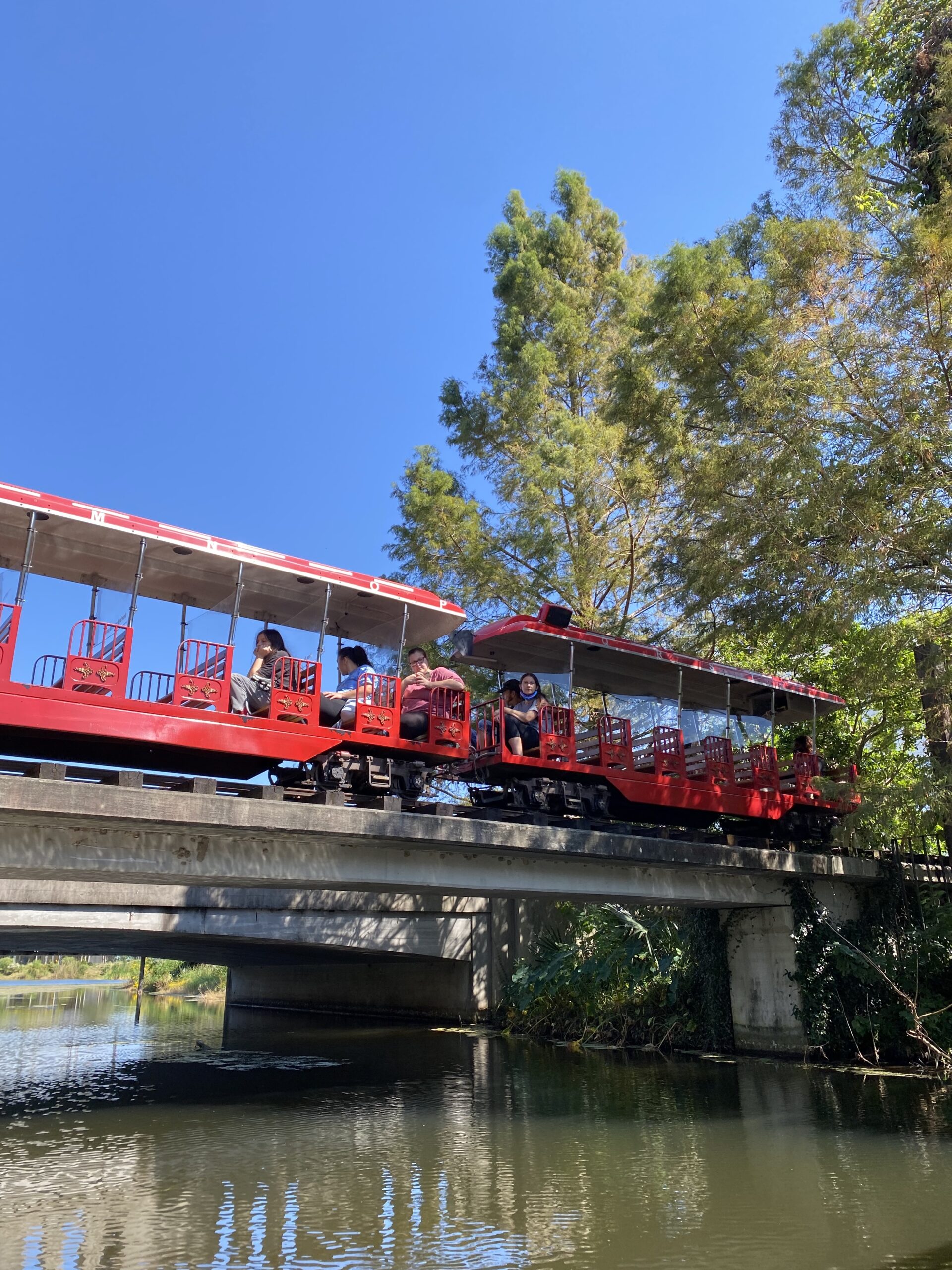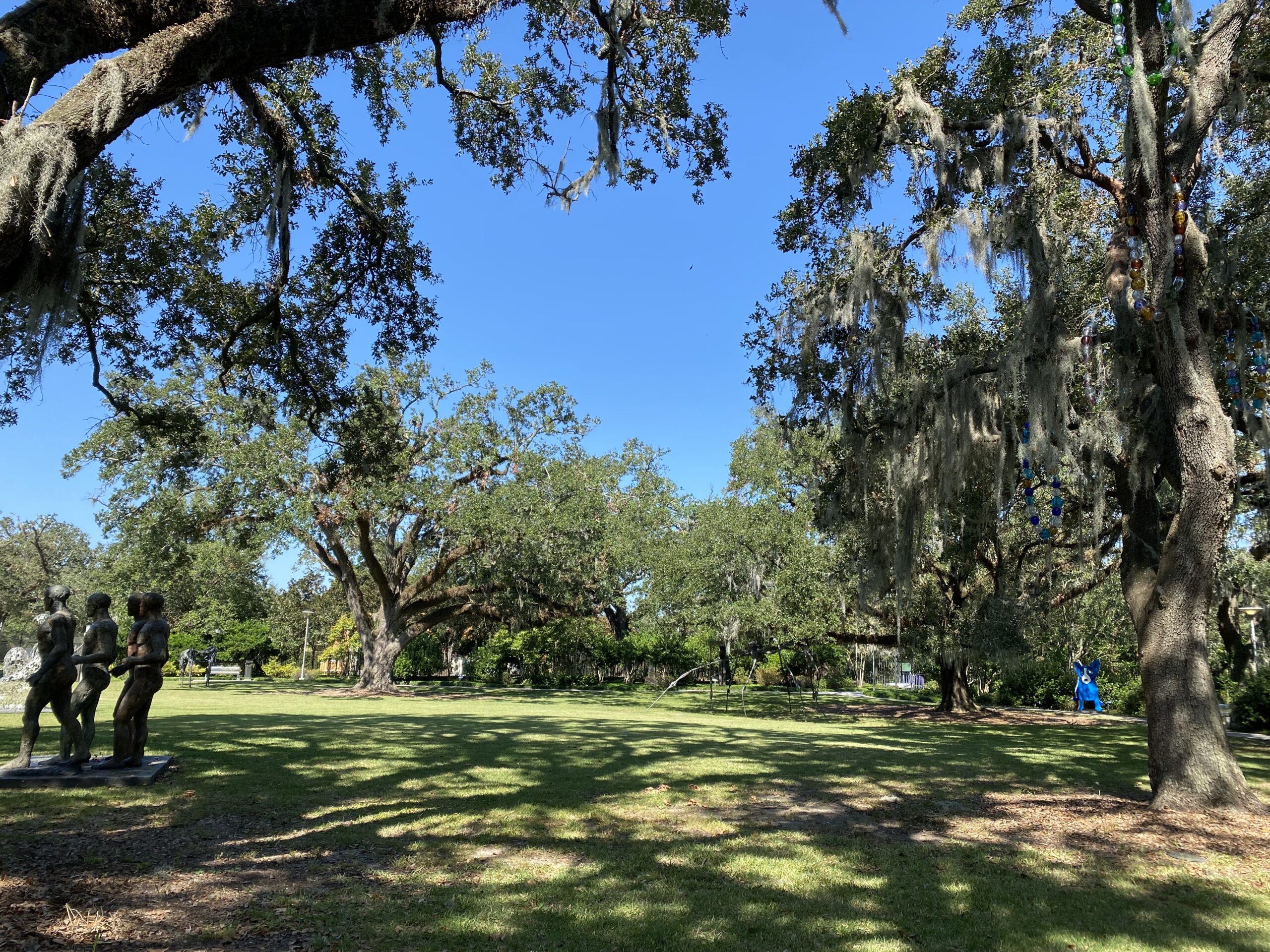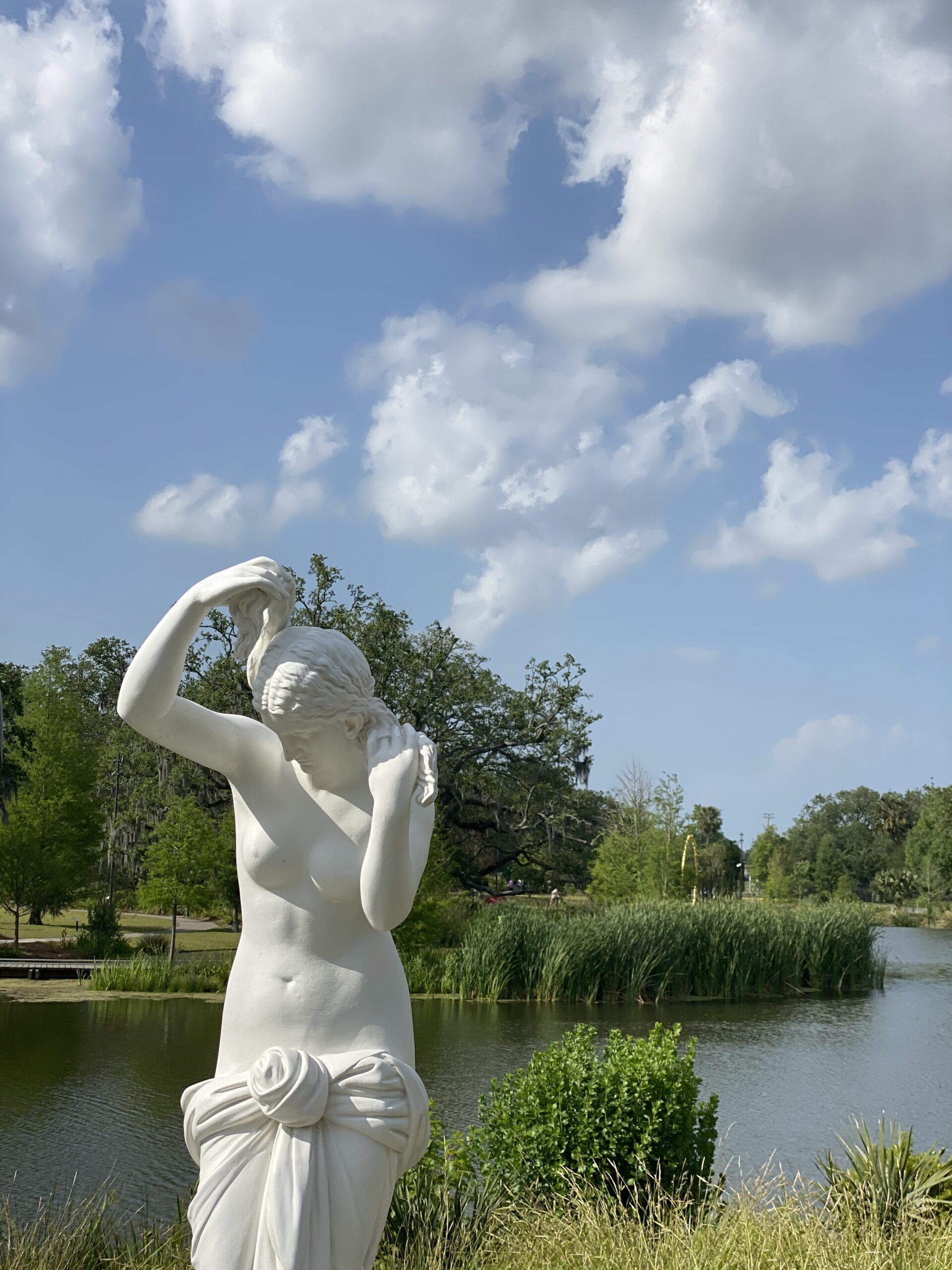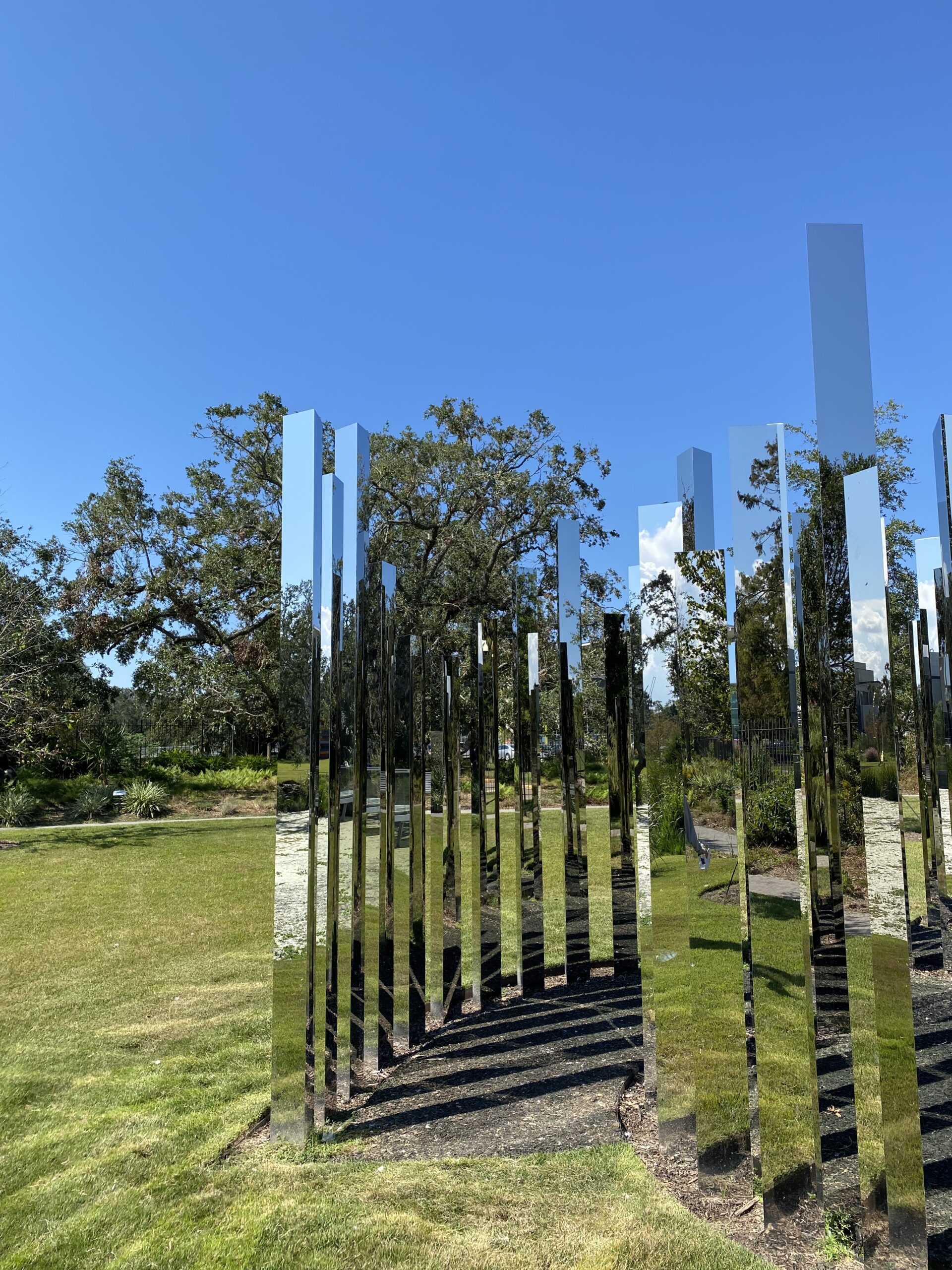I enter the space of what feels like a futuristic dome. Enclosed in this dome are draping oak tree branches, patches of unkempt grass, glistening metal structures, and clay formations peeking in through every angle. The Besthoff Sculpture Garden in City Park around noon on a Friday feels like a trip to a new planet. The gates surrounding the garden are hidden, but I see glimpses of blue bicycles zoom by, fellow viewers enjoying their visit, and the sound of a children’s cho-cho train guiding other viewers through the park.

Train in the Garden. Photo by: Elizabeth Byer
Even though I have explored the sculpture garden several times, every time I return I am surprised by the sense of calm that comes over me. I don’t feel the need to check my phone or think about the assignments looming over my week, the garden is a place to escape and wander in a new capacity. The sculpture garden provides a mind space to turn that stress into a means of imagination and exploration of creative thought. This space not only provides a means to view art but also dive into the concept of voyeurism, how we can use this term in a positive light, stripping away the negative connotation that follows it. Voyeurism in its most basic form is “the practice of taking pleasure in observing something private, sordid, or scandalous.”

Open space in the garden. Photo by: Elizabeth Byer
In a study of Degas’s Brothels artwork, Charles Bernheimer examines the role of voyeurism through the view of the “male gaze”. Specifically looking at one example to see this truly come to life is through the observations of The Tubpainting. This painting illustrates a naked woman, “the woman’s body in The Tub, … folds over on itself in a reflexive movement signifying circularity and closure” (Bernheimer 164). In this circumstance, the voyeur takes on the perspective of looking at a woman as an object, and nothing more: a “woman’s body is perceived as other only insofar as it can be marked with the signs of man’s desire for himself”(Bernheimer 164). Voyeurism takes on the lens of violating one’s privacy, especially in a sexual capacity through Degas’s work, strictly through the eye of a man. “According to the psychoanalytic account, the male voyeur is trying to escape anxiety by obsessively reenacting an original trauma, his imagined perception of female castration, from a situation of mastery and control” (Bernheimer 163). In multiple ways, my experience in the sculpture garden allows me to explore voyeurism in a respectful way, diminishing the negative traits that reflect women.

Sculpture of a woman. Photo by: Elizabeth Byer
Not only does the garden provide a space to observe standing art in different mediums, but the garden also provides a space to observe the people who share a common interest. They chose to go to this space at the same time as me. It is inherently normal to watch the people that pass by, they are in my path of sight, therefore I look and continue to imagine what is going on in their minds.
In a similar way, we can see this through the constant viewership of reality television. No matter the theme of the show, it is an outlet for the common person to see the life of someone else, possibly someone they aspire to live like or the opposite, “We can watch people compete in challenges of physical and mental endurance for monetary rewards and cheer on our favorite contestants, secretly wishing we could compete”. In a real-life scenario, these same thoughts can occur. In the setting of sitting on a bench, taking in the works of many artists, I took time to watch the living people present rather than just the clay cast people propped up on a bench next to me. From afar, the green bench looks like it has white, abstract pieces sprawled across it. But in reality, once you get a little bit closer the details of arms, crossed legs, cheekbones, and face formations become apparent. The bench of clay-casted people allows me to become one with the garden, sitting down as if I were sitting next to a friend. To escape my own thoughts, I sit with my new clay friends and I listen to fellow viewers’ conversations, understand their stressors of the day. Not only is this common for me, but it is in our human nature to be curious about other people’s conversations, an unharmful aspect of voyeurism. For example, a group of young adults sitting next to me was gossiping about their upcoming event, one saying, “it would be weird if you didn’t invite Danielle.” Although this is the only part of the conversation I heard after the people continued on their walk I wondered if Danielle was invited to the event. I wondered if any form of conflict came from debating Danielle’s invitation. I have been in the speaker’s shoes before; therefore, I know the struggle of this question and can create my own outcome of their problem. I have no relation or knowledge to this group of people, but the curious voyeur wants to invade the privacy of others.
In the later part of my walkthrough, I came across a large transparent box made out of pink and orange plexiglass. Not only does it contrast the environment in which it is placed, but it challenges the typical sculpture piece. I can see through it with a pink and slightly foggy filter. The box is about the height of an average female, just the right height to clearly see the person observing from the other side. I can make out their body language, facial expressions and question whether they enjoy this piece or not. They, nor I am asking to be looked at, but the pink and orange transparent box invites us to do so without hesitation.
As much as I watch others, I presume others observe my habits and actions in the garden. This is the alternative side to voyeurism where we can feel like the subject, being starred at and critiqued. In a study of understanding the pleasure of looking and being looked at, Luis F. Gonzalez shows this through analyzing voyeurism and shame. As the one who is now being observed, the opposing feeling is present, “Shame, however, is also associated with being the passive object of the gaze” (Gonzalez 89). Unlike the depiction seen through Degas’s work, voyeurism here expands to both parties present. I am respectfully invading one’s privacy by simply observing, as they do the same to me in this public space.
The sculpture garden has the opportunity to cultivate voyeurism, and it provides ways that voyeurism, in its true fashion is not present, for everyone’s safety. There is no viewing of sexual intercourse, nor objectifying women to the simple means of pleasure, disregarding their role as equal humans. Rather the garden illuminates the artist’s name through metal-plated plaques at the base of every sculpture, drawing the eye to the gold rim to give proper credit. As I exit the garden, I have my last chance to be a voyeur, walking through a maze of mirrored pillars. The abstract path allows for reflection at nearly every angle, even reflecting the image of voyeurs on the opposite side, like the pink and orange box. At first glance, this place may not feel like it has the capacity to do so, but there is a chance to be engaged in the positive lights of voyeurism.

Mirror maze. Photo by: Elizabeth Byer
Work Cited
Bernheimer, Charles. “Degas’s Brothels: Voyeurism and Ideology.” Representations, no. 20, University of California Press, 1987, pp. 158–86, https://doi.org/10.2307/2928506.
González, Luis F. López. “Voyeurism and Shame: The Pleasure of Looking and the Pleasure of Being Looked at in <em>La Celestina</Em>.” Celestinesca, no. 40, Publicacions Universitat de Valencia, 2016, pp. 87–116, http://www.jstor.org/stable/26167868.
Lehrer, Jonah. “The Science of Eavesdropping.” Wired, Conde Nast, 10 Sept. 2010, www.wired.com/2010/09/the-science-of-eavesdropping/.
Sovie, Stephen. “Why Do People like to Be Entertained by Other People’s Lives?” Medium, The Partnered Pen, 3 Oct. 2019, medium.com/the-partnered-pen/why-do-people-like-to-be-entertained-by-other-peoples-lives-57471c981cad.
“Voyeurism.” Merriam-Webster, Merriam-Webster, www.merriam-webster.com/dictionary/voyeurism.
 NOLAbeings
Multimedia artist Claire Bangser created NOLAbeings as a portrait-based story project that marries...
NOLAbeings
Multimedia artist Claire Bangser created NOLAbeings as a portrait-based story project that marries...
 Data corner: Adobe Suite (create a PDF, social media graphic, presentation, edit a photo and video
Data corner is where you go to work with analytics and top tech skills. It takes on everything from PERL and SQL to Canva and Sprout Social.
Data corner: Adobe Suite (create a PDF, social media graphic, presentation, edit a photo and video
Data corner is where you go to work with analytics and top tech skills. It takes on everything from PERL and SQL to Canva and Sprout Social.
